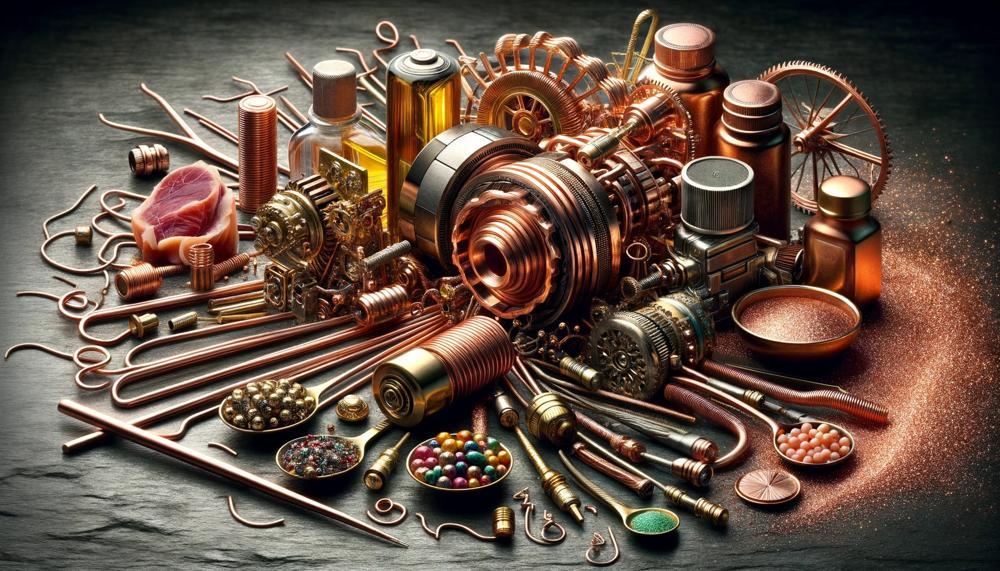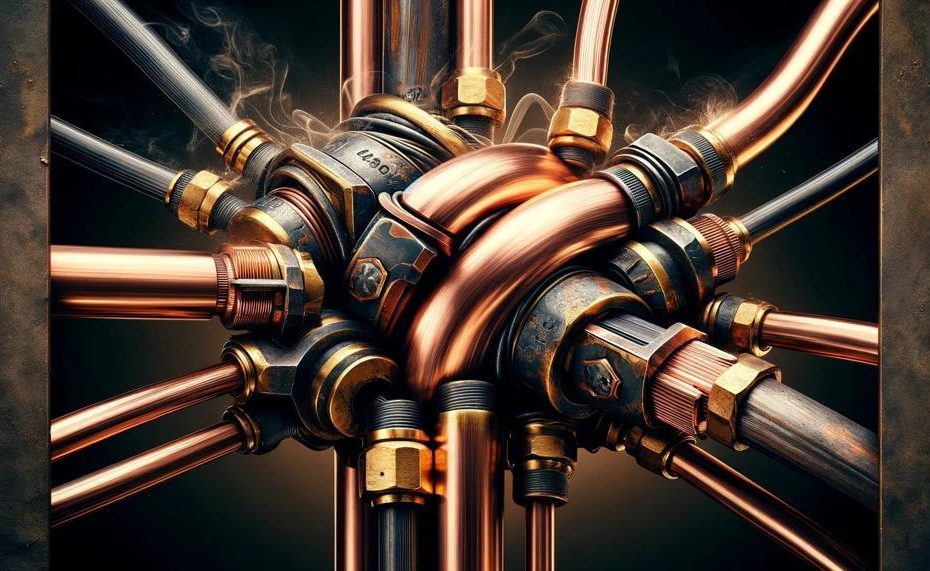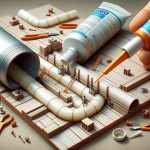We’re going to explore a fascinating subject today that may inspire your next do-it-yourself project or help you learn more about metalworking. Is it possible to adhere copper to brass using adhesive? You are, in fact, at the proper spot. The purpose of this blog post is to solve the puzzle and offer you the knowledge you need to go out on your own metallic adventures.
So, can I glue copper to brass?
Yes, you can glue copper to brass, but soldering is generally considered the best method. Soldering uses a low-melting point metal alloy to bond two pieces of metal together. However, some glues, like epoxy, can be useful for gluing copper to brass. However, these glues can create brittle bonds, so if the item is knocked, it may part.
So, let’s delve into the art of metal adhesion that could elevate your projects to the next level.
Table of Contents
- 1 Adhesive Bonding Basics
- 2 Selecting the Right Adhesive for Copper and Brass
- 3 Surface Preparation for Adhesive Bonding
- 4 Mechanical Bonding Techniques to Enhance Strength and Durability
- 5 Tips for Applying Epoxy Adhesives to Copper and Brass
- 6 Benefits of Gluing Copper to Brass
- 7 Challenges with Gluing Copper to Brass
- 8 Troubleshooting Common Issues with Glue Bonds between Copper and Brass
- 9 Conclusion
Adhesive Bonding Basics
When looking to bond copper to brass, it’s like fitting together two pieces of a puzzle with distinct characteristics. Here’s a crisp guide to what you should consider for a successful adhesion:
| Factor | Why It’s Important | How To Nail It |
| Cleanliness | Prevents poor adhesion due to oxidation or contaminants. | Use a solvent or degreaser to clean surfaces. |
| Adhesive Compatibility | Ensures the glue can handle the unique properties of both metals. | Choose epoxies, cyanoacrylates, polyurethanes, or silicones known for metal bonding. |
| Environmental Conditions | Affects adhesive performance and curing. | Adhere to recommended temperature and humidity levels. |
| Clamping and Curing | Ensures close contact and a strong bond during adhesive curing. | Use metal-appropriate clamps and allow for a full 24-hour cure time. |
Selecting the Right Adhesive for Copper and Brass
Selecting the right adhesive for copper and brass involves a keen understanding of both the metals and the adhesive’s properties.
Here’s a distilled guide to navigating this selection process, ensuring a bond that’s not just strong but lasting.
Compatibility
First off, the adhesive must play nice with both copper and brass. Epoxy stands out as a top pick due to its ability to form steadfast bonds with a variety of metals, including our duo of interest.
Strength
It’s all about the hold. The adhesive needs the muscle to keep copper and brass together under the pressures and strains they’ll face.
Epoxy again takes the crown for its remarkable tensile strength, ensuring the bond holds tight under load.
Curing Time
Time is money, and in the world of adhesives, curing time translates directly into productivity.
A quicker set means less downtime. Epoxy adhesives, known for their relatively swift curing times, ensure you’re not left watching paint dry.
Environmental Resistance
Last but not least, the chosen adhesive must withstand the elements—heat, moisture, and chemicals that the copper and brass union is likely to encounter. Epoxy’s resilience across these conditions makes it a solid choice for applications where environmental stressors are a concern.

Surface Preparation for Adhesive Bonding
Prepping copper and brass for a solid stick involves a few critical moves. Let’s break it down step by step, ensuring your metals are primed and ready for that unbreakable bond.
| Step | Action | Tips |
| Clean | Use degreaser or acetone | Ensure complete dryness afterwards |
| Sand | Lightly with 220 grit sandpaper | Aim for a uniform texture |
| Deoxidize | Apply deoxidizing solution | Wipe off after a few mins |
| Prime | Apply an adhesive primer | Choose one compatible with both metals |
| Glue | Use epoxy adhesive | Follow adhesive instructions closely |
Stick to these steps, and you’re not just bonding metals; you’re crafting a relationship between copper and brass that’s meant to last.
Mechanical Bonding Techniques to Enhance Strength and Durability
When it comes to marrying copper and brass, a few select mechanical bonding techniques stand out for their ability to foster strong and enduring unions.
Each method, from riveting to welding, brings its own strengths to the table, depending on the project’s demands for durability and resilience.
Table of Techniques:
| Technique | Best For | Strength Level |
| Riveting | Heavy Loads, Vibrations | High |
| Crimping | Permanent, Non-Movable Bonds | Moderate to High |
| Soldering | Electrical Connections | Moderate |
| Brazing | Industrial Strength Applications | Very High |
| Welding | Unbreakable Bonds | Extremely High |
Selecting the right bonding technique hinges on the project at hand. Factors like the need for movement, exposure to stress, and whether the bond must conduct electricity guide the choice.
Each method has its place, whether you’re crafting a piece that calls for the elegance of brass and copper or engineering a structure where their strength shines.
Tips for Applying Epoxy Adhesives to Copper and Brass
When aiming to bond copper and brass with epoxy adhesives, knowing the best practices ensures a strong, lasting union between these metals.
Each step, from surface preparation to the application, plays a critical role in the bonding process. Here’s how to get it right:
Surface Preparation
| Step | Action | Purpose |
| Cleaning | Use acetone or a similar solvent to clean the metal surfaces. | Removes grease, dust, and other contaminants that weaken the bond. |
| Roughening | Gently sand or use a wire brush on the metals. | Creates a textured surface for better adhesive grip. |
Mixing the Epoxy
Ensure you follow the manufacturer’s ratio for resin to hardener meticulously. A precise mix is crucial for achieving optimal strength.
Environmental Conditions
Operate in an environment with a temperature between 60-80°F (15-27°C) and low humidity. These conditions are ideal for epoxy curing.
Application and Curing
- Apply the mixed epoxy to one surface and join the two metals together, applying firm pressure to ensure complete contact.
- Use clamps to hold the pieces in place, ensuring a tight bond as the epoxy cures.
- Allow at least 24 hours for the epoxy to fully cure before handling or loading the bonded metals.
Post-Bonding Care
After the adhesive has cured, keep the bonded metals away from extreme temperatures and harsh chemicals to maintain bond integrity. Regular checks for any signs of wear or separation can help address potential issues early.
Remember, a successful bond not only relies on following these steps but also on choosing the right epoxy adhesive for copper and brass. Opt for products specifically designed for metal bonding, capable of withstanding the conditions the metals will be exposed to, whether it’s heat, moisture, or chemicals.
Benefits of Gluing Copper to Brass
Gluing copper to brass boasts a myriad of benefits, making it a favoured technique in diverse sectors like plumbing, electronics, and jewelry crafting. Let’s dive into the specifics:
Ease of Use:
Glue’s simplicity is its biggest charm. Unlike the intricate processes of welding or soldering, gluing requires no fancy tools or high-level skills.
A dab here and a stroke there with a basic applicator, and you’re set, making it perfect for both seasoned pros and weekend warriors.
Adhesive Versatility:
The glue market is a treasure trove of options. For copper and brass, the champions are epoxy and cyanoacrylate (super glue).
These tough cookies handle high temperatures like champs, ensuring a robust bond ideal for metalwork.
Strong Chemical Bond:
Glue isn’t just sticky; it’s chemically adept. When marrying copper and brass, glue forms a bond tough as nails, capable of withstanding both stress and pressure, essential for these divergent metals.
Heat-Free Bonding:
No scorching heat needed here. This means no warping or weakening of your precious metals, plus a delightful absence of burn risks. A cooler, safer bonding avenue indeed.
Cost-Effectiveness:
Save your pennies. Welding and soldering demand specialized, pricey gear. Glue, in contrast, is a wallet-friendly hero available at your local hardware haunt. Quick setting times also mean less clock-watching, more doing.
Gap Filling:
Got an awkward space? Glue’s got your back. It nestles into nooks and crannies, ensuring a seamless and fortified joint, even on the most whimsical of metal shapes.
Sealant Properties:
Glue’s talents include playing the guard against moisture and air, a crucial shield for plumbing and electrical applications, where rust and oxidation are uninvited guests.
Aesthetic Finish:
Seeking a clean, professional look? Glue is your invisible friend, leaving no trace, no discoloration – just a sleek, unblemished joint.
Challenges with Gluing Copper to Brass
Gluing copper to brass isn’t a walk in the park, thanks to a couple of sneaky challenges that tend to throw a spanner in the works. Here’s a rundown of the hurdles you might face:
| Challenge | Details | Solution |
| Different Surface Properties | Copper and brass, while cousins in the metal family, don’t play all that nicely when it comes to gluing because of their different levels of reactivity and surface textures. | Choosing an adhesive that’s up to the task of dealing with these differences is key. Look for one that’s specifically marked for mixed-metal applications. |
| Oxide Layers | Both metals sport a stylish coat of oxide that, unfortunately, acts more like a barrier to adhesives than a welcome mat. | A bit of elbow grease and the right cleaning agent can strip these layers down, making for a more glue-friendly surface. |
| Brass’s Composition | Brass is not just any metal; it’s an alloy with a mix of copper, zinc, and sometimes other elements, complicating the glue’s bonding capability. | An adhesive designed for alloys or with flexibility in bonding different metals will often offer a stronger hold. |
| Thermal Expansion | Heat them up, and these metals will expand at different rates, putting stress on your glued joint and potentially leading to a break-up. | Employing adhesives that can handle a bit of movement or thermal variation without cracking can mitigate this issue. |
| Adhesive Selection | Not all glues are created equal, especially when it comes to bonding copper and brass. | Invest in a specialized metal adhesive, and don’t skimp on quality. It makes all the difference. |
| Surface Preparation | Like any good relationship, a strong bond starts with a clean slate; any contaminants or oils can weaken the adhesion. | Thoroughly clean and, if possible, lightly roughen both surfaces before applying your adhesive for the best adhesion. |
Troubleshooting Common Issues with Glue Bonds between Copper and Brass
When you’re attempting to stick copper and brass together, a couple of stubborn problems might pop up. Let’s dive into what these are and how to sort them out:
Surface Smoothness vs. Roughness
- Copper: Often as slick as a rain-slicked street.
- Brass: A tad more texture, like a well-used footpath.
Oxidation – The Unwanted Visitor
- Copper and Brass: They both love to tarnish as much as a silver spoon left out in the rain.
Chemical Composition – The Inner Turmoil
- Brass: This one’s a bit of a mix-up, with zinc making the glue’s job tougher than chewing through a leather boot.
The Toolkit for Triumph
So, how do we tackle these tricky issues? With a bit of preparation and the right glue, we’re on our way to victory.
| Problem | Solution | Recommended Action |
| Surface Differences | Sanding for Harmony | Gently sand both surfaces to create a texture that glue can cling to like a cat to a warm lap. |
| Oxidation | Adhesive Primer | Apply a metal primer to chase away any oxidation and give the glue a fighting chance. |
| Chemical Composition | Choosing the Right Glue | Opt for epoxy or polyurethane-based adhesives, known for their strength and ability to cope with a bit of complexity. |
Conclusion
A voyage through the craft of metal adhesion, the process of gluing copper to brass is a ballet of care and precision that leads to a plethora of practical and artistic opportunities. We’ve learned that applying glue alone won’t be sufficient to create a solid link between these two noble metals as we’ve explored the subtleties of this procedure.
It requires a well-balanced combination of careful surface preparation, appropriate adhesive selection, and knowledge of the environmental factors influencing the curing process.
In this regard, epoxy wins out because it provides the strength, compatibility, and resilience required to endure the many pressures and elements that these metals may experience. It’s important to prepare the copper and brass canvases to receive the connection that epoxy promises to form, thus bonding involves more than just the glue.
When we reveal this metallic symphony, it becomes clear that the true magic is not only in the adhesive but also in the painstaking planning, execution, and perseverance.






